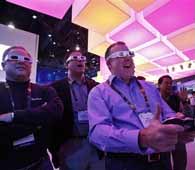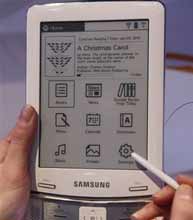VOICE ONE:
This is SCIENCE IN THE NEWS in VOA Special English. I'm Faith Lapidus.
VOICE TWO:
And I'm Bob Doughty. This week, we look at the newest devices demonstrated at the recent International Consumer Electronics Show. The show offered a look at what could be the most popular electronic products this year.
(MUSIC)
VOICE ONE:
The Consumer Electronics Show is the world's biggest technology trade show. Industry representatives and reporters gather at CES each January to see the next, must-have electronic devices for the coming year.
This year, the show took place between January 7th and 10th in Las Vegas, Nevada. A record 330 businesses attended for the first time. These can be manufacturers or suppliers who sell products from other companies. In all, there were over 20,000 new products from more than 2,500 businesses.
The Consumer Electronics Association produces CES. It is the largest trade show of any kind in North America -- with over 130,000 square meters of exhibition space.
VOICE TWO:
The electronics industry is hoping a new crop of products will help it recover from an eight percent decrease in sales last year. The biggest attention-getters were the latest 3-Dimensional high definition televisions.
Tara Dunion is a spokeswoman for the CES. She says 3-D televisions promise to bring the intense experience from movie theaters to the home. The huge popularity of 3-D films like "Avatar," "Up" and "Monsters vs. Aliens" has many people willing to buy this costly, developing technology.
Dreamworks Animation made "Monsters vs. Aliens" and the popular Shrek series. The company announced last year that it would only make 3-D films in the future. And, television networks ESPN and Discovery Communications say they plan to operate television channels in 3-D. Big TV manufacturers like LG Electronics, Panasonic, Sony and Samsung have all developed their own products.

VOICE ONE:
If you have seen a 3-D movie, you already know that you need special eyeglasses to watch. Some 3-D TVs do not require special glasses. But experts say it will be years until such technology is ready for the general market.
The latest 3-D TVs work by dividing picture images in two, one for each eye. When each eye sees very similar, but different versions of an image, the brain thinks it is seeing depth, or three dimensions.
Dividing the image can be done in two ways -- both using special eyeglasses. One 3-D technology uses low-cost polarized glasses. Each side of these devices blocks a set of images that appear in a different form of polarized light. So each eye sees a slightly different image, producing the 3-D effect. But TV receivers that use what is called a passive glasses system are costly.
VOICE TWO:
An active glasses system requires electronic glasses that are wirelessly connected to the television. A signal from the TV tells each side of the glasses when to turn on and off, showing each eye slightly different images that create the sense of depth. The switching happens so fast that the images appear continuous.
Active eyeglasses cost more -- about 100 dollars each. But the technology for such receivers is not too different from current flat screen TVs.
There were examples of both technologies at the 2010 International CES. There were even 3-D TVs that require no glasses at all. But 3-D TVs are expected to cost a lot – with one selling for several thousand dollars. Still, the Consumer Electronics Association predicts that more than four million 3-D TV sets will be sold this year.
(MUSIC)

VOICE ONE:
Digital tablets and eBook readers could also be popular this year. These easy-to-hold devices let you read and watch media or search the Internet and order products. Dell and Hewlett-Packard exhibited new tablet devices at CES.
Lenovo demonstrated a product that can be used as two computing devices. The IdeaPad U-One Hybrid is a notebook computer, which has a removable screen that becomes a digital tablet. Amazon showed versions of its popular Kindle eBook reader. Barnes & Noble, Samsung, Sony and other companies also showed models of eBook readers.
VOICE TWO:
But Apple made the biggest news when it announced that it would offer its own digital tablet this year. Apple did not show the product at CES, but industry watchers are extremely interested. Media reports say Apple plans to announce the tablet, possibly called the iSlate, later this month.
Like netbooks, tablets are less costly ways to use the World Wide Web and digital information. Some experts think these easily carried devices could represent the future of computing. But their lower price means smaller profits for manufacturers and sellers.
VOICE ONE:
Wireless telephones could be a big part of the electronics industry's return to growth. At the start of CES, Consumer Electronics Association President Gary Shapiro made some predictions. He said 52 million wireless phones will be sold in the United States this year.
Smartphones represent over 30 percent of the market. They are phones that search the Web, send messages and carry out applications. Their share of all mobile phones is only expected to grow.
VOICE TWO:
Google launched its Nexus One smartphone, which the company calls a "superphone," at CES. This is Google's first attempt to sell its own electronic device. Nexus One will directly compete with Apple's popular iPhone. It uses Google's Android mobile operating system and is meant to work easily with Google's Web-based services.
Nexus One, though, is not the only new smartphone that uses Android. Several big phonemakers are coming out with Android-based mobile phones.
And, there is another group of mobile devices to watch for: Smartbooks. These are smaller and cost less than netbooks, while still having a keyboard. They are meant for looking at Web pages and placing information on Twitter. Manufacturers are still developing smartbooks. But they are products to watch in the future.
(MUSIC)
VOICE ONE:
Sustainable technologies have been a growing part of the International Consumer Electronics Show for years. The CES has an area for companies to demonstrate products that save energy, reduce waste and reuse materials.
Show spokeswoman Jennifer Bemisderfer says the Sustainable Planet Tech Zone is four times bigger than last year. Among the products were TVs that use light emitting diodes, or LEDs, to save energy. Some manufacturers are increasingly interested in what has been called cradle to cradle technology. Jennifer Bemisderfer says this involves thinking about a product's whole lifetime:
JENNIFER BEMISDERFER: "When those products are at the end of their useful life, how are they going to be broken down? How are we going to get some of the essential elements out of those products and have them reused in the manufacturing process?"
VOICE TWO:
Many of the products shown at CES require wireless connections to the Internet. Julius Genachowski is the chairman of the Federal Communications Commission, which supervises broadcasting and communications. Mr. Genachowski spoke at the show about the technical problems that wireless devices present.
He says they depend on a limited number of radio wavelengths. But he says the problem can be solved. And, he hopes to increase wireless Internet access across the United States.
Mr. Genachowski told CES that wireless technology, or broadband, can be an engine of economic growth. And, he noted its importance to the country's social goals.
JULIUS GENACHOWSKI: "Promoting our common goals around education, health care, energy, public safety, and, I think in each of those areas, you actually see on the floor here new innovative ideas to take advantage of this general purposes technology that broadband is, and apply it to provide better services at lower cost in each of these areas."
Mr. Genachowski said government has a limited part in technology development. He said most investment is private. But he said his agency hopes to support progress by getting investors interested in new technologies.
(MUSIC)
VOICE ONE:
This SCIENCE IN THE NEWS was written and produced by Mario Ritter with reporting by Mike O'Sullivan in Las Vegas. I'm Faith Lapidus.
VOICE TWO:
And, I'm Bob Doughty. Join us again next week for more news about science in Special English on the Voice of America.
diode: an electronic device in which the electric current passes in one direction only, for example a silicon chip (电子)二极管
(来源:VOA 编辑:陈丹妮)
